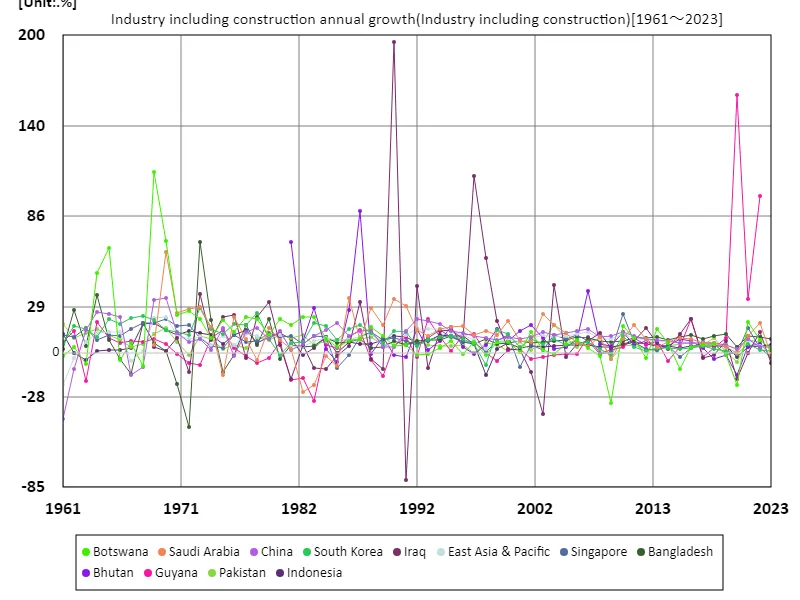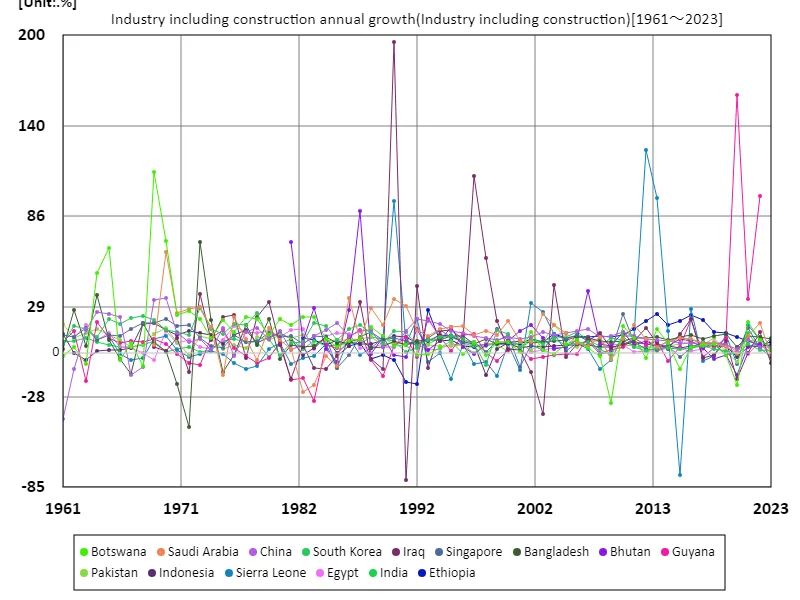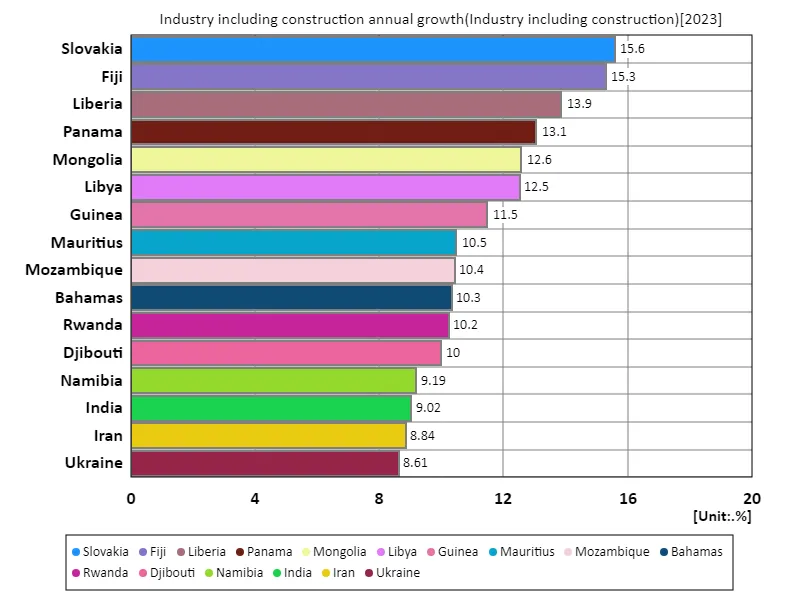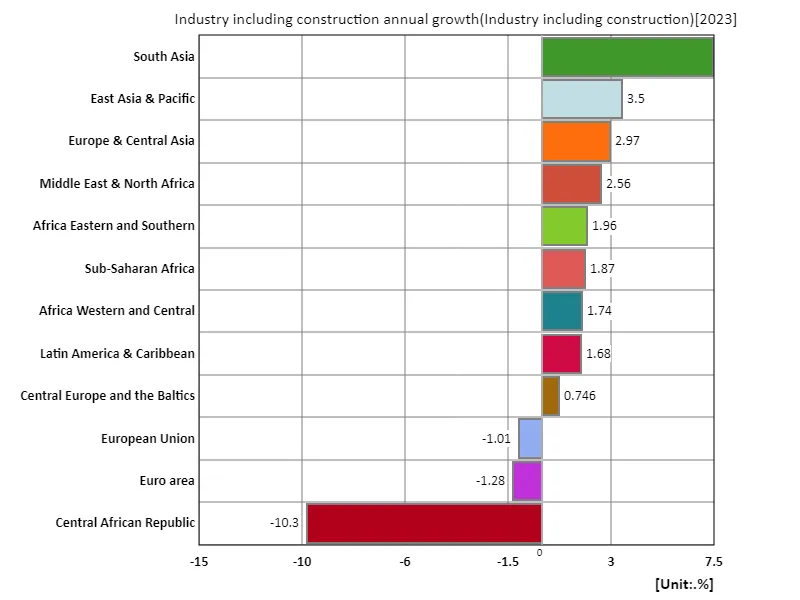Abstract
Bangladesh’s high annual growth rate of industries, including the construction industry, of 8.37% in 2023 indicates the rapid progress of the country’s economic development. In recent years, Bangladesh has been attracting attention as a rapidly growing emerging market, with infrastructure development in particular being a key factor supporting its economic growth. The rapid growth of the construction industry is driven by increasing demand due to increasing urbanization, population growth, and the inflow of foreign capital. Additionally, government infrastructure investment policies and the expansion of public works are also supporting growth in the construction industry. In contrast, other emerging and developing countries may not experience as high growth rates as Bangladesh due to political instability and economic stagnation. Overall, the growth of Bangladesh’s construction industry is a positive sign of healthy overall economic development and increasing urbanization.
Industries including construction, annual growth rate
Data from 1961 to 2023 show that the most notable increase in annual growth rate of industry, including agriculture, forestry and fishing, was recorded by Iraq in 1990, at a staggering 196%. This extraordinary growth rate was the result of unusual economic policies and large-scale state-led agricultural development projects at the time. However, Iraq has now fallen far behind its growth peak, showing a low growth rate of -3.23%. This is because war, political instability and economic turmoil have had a profound effect. A look at trends over the past few decades shows that growth rates in the agriculture, forestry and fisheries sectors have been highly volatile in many countries. External factors such as war, political unrest and natural disasters have a direct impact, leading to large fluctuations in growth rates. For example, while industrial processes are becoming more mechanized and efficient in developed countries, emerging countries are experiencing growth driven by infrastructure development and investment. Overall, the growth rates of agriculture, forestry and fisheries tend to vary greatly depending on the region and time, with a variety of intertwined economic and social factors behind them.


The maximum is 196%[1990] of Iraq, and the current value is about -3.23%
Industries including construction, annual growth rates (worldwide)
Looking at data from 1961 to 2023, the annual growth rates of industries, including construction, vary widely across regions and time periods. In particular, Iraq in 1990 recorded an extraordinary growth rate of 196%. This was the result of Iraq’s proactive infrastructure development at the time, which promoted rapid economic growth. However, Iraq has since been hit by war, political instability, and economic collapse, and its current growth rate has fallen significantly to -3.23%. This sudden fluctuation shows how significant an impact national stability has on economic growth. Overall, the growth rate of any industry, including the construction industry, often depends heavily on political and economic factors. Wars, economic crises, and policy changes have a direct impact and cause large fluctuations in growth rates. In developed countries, technological innovation and efficiency are progressing and growth tends to be relatively stable, but emerging and developing countries are experiencing rapid growth due to infrastructure investment and urbanization, but there are also many factors that cause instability. This makes industrial growth, including the construction industry, an important indicator of the overall health of the economy and the stability of the nation.


The maximum is 196%[1990] of Iraq, and the current value is about -3.23%
Industries including construction, annual growth rate (nationwide, latest year)
According to data for 2023, Slovakia recorded the highest annual growth rate for industry, including construction, at 15.6%, followed by an overall average of 1.84% and a total of 282%. The data shows that the construction industry exhibits significant fluctuations depending on region and economic conditions. Slovakia’s rapid growth is due to the country’s economic development and increasing investment in infrastructure. In recent years, Slovakia’s construction industry has experienced rapid growth thanks to support from the EU and the promotion of domestic infrastructure projects. This makes the growth rate higher than other countries. However, the overall average growth rate of 1.84% suggests that the construction industry in many countries is stable or is growing slowly. This is because in developed countries, rapid growth is often difficult as the main focus is on maintaining and upgrading existing infrastructure. Although urbanization and infrastructure development are progressing in emerging countries, economic instability and investment uncertainty can affect growth. The combined growth rate of 282% reflects the differences between individual fast-growing and stable-growing countries, but indicates that growth is more balanced overall. The growth of the construction industry is strongly influenced by regional economic trends, policies and investments, making it an important indicator of the economic situation in each country.


The maximum is 15.6% of Slovakia, the average is 1.8%, and the total is 273%
Industries including construction, annual growth rate (region, latest year)
According to 2023 data, global agriculture, forestry and fisheries value added totaled US$4.72 trillion. In particular, East Asia and the Pacific region accounted for the largest share, at US$1.64 trillion. In this region, many countries, including China, are promoting large-scale agricultural production and technological innovation, making the agricultural sector a key driver of economic growth. On the other hand, as the sustainability and environmental impact of agriculture come into question, efficient use of resources and environmental protection are becoming more important. With an overall average value added of US$363 billion, agriculture provides a stable economic base globally. However, climate change and weather instability are having an increasing impact on agricultural crops, and appropriate measures are needed. Going forward, it will be necessary to promote sustainable agriculture, disseminate technology, and strengthen international cooperation. Addressing these challenges is essential if agriculture, forestry and fisheries are to remain key pillars of global food security and economic growth.


The maximum is 7.45% of South Asia, the average is 993m%, and the total is 11.9%



Comments